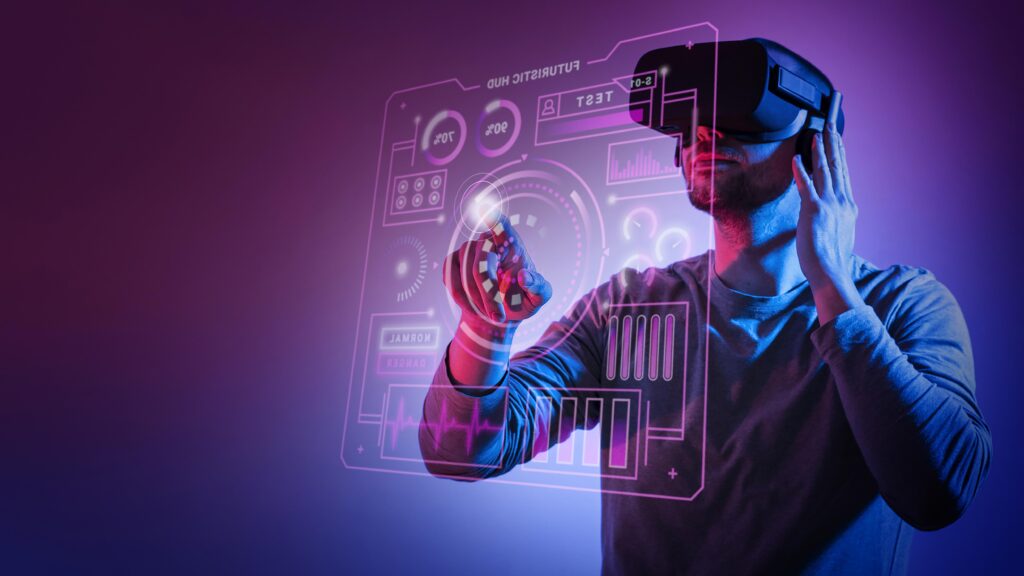The Dawn of a New Digital Era
The metaverse represents an unprecedented convergence of technologies that promises to fundamentally reshape the digital landscape. By combining cryptocurrency, AI, AR/VR, and spatial computing into expansive virtual worlds, the metaverse has the potential to revolutionize entertainment, commerce, communication, and even the nature of work itself.
For technology leaders and builders, this new digital frontier presents bountiful opportunities – as well as complex challenges. To successfully navigate this uncharted territory, organizations must craft thoughtful strategies, assemble specialized teams, and invest in developing the required capabilities.

The State of the Metaverse
While still in its nascent stage, the metaverse ecosystem already has some clear leaders staking their claims. Tech giants Meta, Microsoft, Google, and Tencent have made major investments, attracted by gaming, social, and commercial applications. Upstarts like Roblox and Epic are pioneering new models of immersive user-generated worlds and virtual events.
But the borders are not yet defined. The coming years will see intensifying competition, continued disruption of traditional business models, and new players entering the arena. The technology leaders who can capitalize on this uncertainty – by building adaptive, user-focused applications powered by interoperability and emerging tech – stand to shape the infrastructure of the metaverse.
Strategic Considerations
When approaching the metaverse, technology leaders should ground initiatives in clear business goals and market realities while allowing room for experimentation.
Discover New Revenue Streams
Virtual goods, in-app purchases, and other models can drive real monetization of digital experiences and assets. Nike, for example, sold $185 million of virtual products in 2021. With users spending more time and money in immersive environments, new markets around digital content creation, advertising, and commerce abound.
Enhance Operational Agility
Digital twins of factories and supply chains are improving manufacturing flexibility, streamlining deployments, and optimizing productivity. Automakers like BMW are simulating entire vehicle development cycles in virtual environments prior to physical production.
Reinvent Brand Interactions
Brands like Starbucks are leveraging VR, AR and gamification to blend digital and physical engagement. By providing value, entertainment and community, companies can gain deeper customer loyalty.
Future-Proof Product Design
In an ecosystem centered on interoperability and accessibility, products must evolve to meet users across platforms ranging from VR headsets to mobile devices. Build with open standards in mind.
Build Your Tribe
Realizing the promise of the metaverse requires multidisciplinary talent combining software engineering, UX design, 3D graphics, security, and technical infrastructure skills. Training programs, strategic partnerships and acquisitions may help secure capabilities.
Maximize Value, Minimize Risk
Approaching innovation with clear goals and guardrails in place helps ensure positive outcomes. Prioritize designs that promote user autonomy, choice, security and privacy.
“As the metaverse becomes more embedded into the fabric of society, it may start to merge more with the physical world. Companies should approach this proactively today with flexible strategies rooted in solving real problems for customers, rather than reactive plans built around technological fads that may be short-lived.”
The Tools and Tech Powering the Metaverse
While the metaverse leverages familiar game development platforms like Unity and Unreal Engine, effectively engineering the next generation of immersive and interconnected virtual worlds requires mastering emerging skill sets spanning a range of critical domains.
Developers must integrate decentralized Web3 protocols enabling user-owned assets, permissions, and tokenized incentives. They need to build real-time 3D experiences optimized for AR, VR, and mixed-reality hardware of all types, powered by spatial computing and reactive to user input. Multiplayer networking architecture ensuring high scalability and low latency communication between users is essential as virtual spaces grow more collaborative. Expertise in creating highly detailed 3D digital assets, characters, and environments using tools like Blender and Autodesk Maya gives life to synthetic worlds. Incorporating AI and generative design allows the automatic production of content attuned to individual user preferences. And simulation technology replicating factories, cities and whole supply chains accelerates prototyping and reduces physical world testing requirements. Though anchored on long-standing graphics engines, assembling a complete, living metaverse requires weaving together infrastructure at the cutting edges of these disciplines.
Success in Metaverse development requires a diverse skill set encompassing programming languages, 3D graphics, networking, user experience design, and security. Developers should continuously adapt and learn new technologies to stay ahead in this rapidly evolving field.
The Road Ahead
The coming years will prove foundational in mapping out our emerging virtual geography. While challenges are plentiful, few technical frontiers have promised such a breadth of opportunities for innovation and human collaboration. By embracing this new frontier with sound strategy, focused investment, and an eye toward solving real user needs, today’s technology trailblazers can play a leading role in shaping our shared virtual future.
